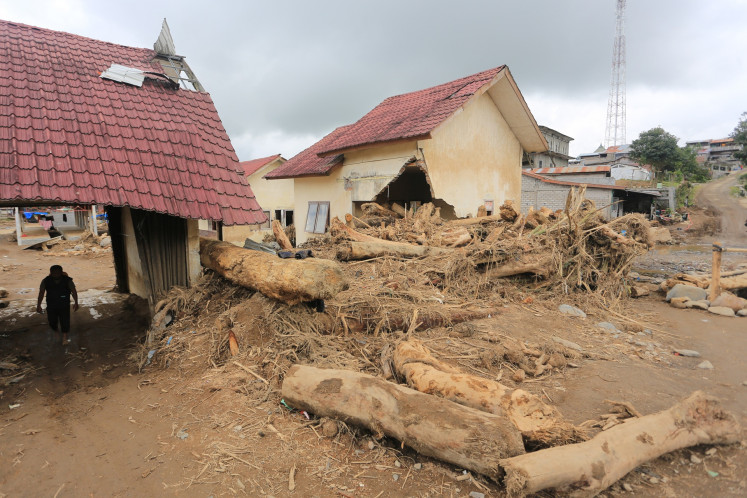Popular Reads
Top Results
Can't find what you're looking for?
View all search resultsPopular Reads
Top Results
Can't find what you're looking for?
View all search resultsBook on Japanese occupation of Java gets republished
(Courtesy of Komunitas Bambu)During World War II, the island of Java experienced major social and political change
Change text size
Gift Premium Articles
to Anyone
(Courtesy of Komunitas Bambu)
During World War II, the island of Java experienced major social and political change.
From 1942 to 1945, the Japanese army occupied Java and launched numerous propaganda campaigns to convince locals to lend their support. Eventually, these campaigns shook the very foundation of Javanese culture, bringing forth new political movements, strategies and social structures.
A book titled Politik Jepang di Jawa: Perubahan Sosial di Pedesaan Jawa 1942-1945 (Japanese Politics in Java: Social Changes in Rural Java 1942-1945) tries to capture the realities of life in Java during the tumultuous three-year occupation, as well as the legacy of the Imperial Army's departure.
The book is written by Aiko Kurasawa, one of the first Japanese historians to examine Indonesia during World War II. It is based on the dissertation she finished in 1988 while studying at New York's Cornell University, titled Mobilization and Control: A Study of Social Change in Rural Java, 1942-1945.
'My research for the dissertation began from zero because when I started it in the 1970's, there was not much documentation or research about villages during the Japanese occupation,' Kurasawa said during a recent book-launching event Jakarta.
'The young generation of Indonesians knew little about life during the Japanese occupation, save for the bits and pieces shared by parents and grandparents.' To complete the dissertation, Kurasawa, who was born shortly after the World War II ended, spent several years researching in the Netherlands and in Indonesia.
'I needed to compile archives about Japanese policy. Policymaking documentation in Tokyo was accessible in Japan, but what happened in the occupied regions was not easy to find,' she said.
After the Japanese surrendered, the Dutch confiscated all the archives stored in the different regions, which is why Kurasawa went to Holland for a year before writing her dissertation in New York.
'Afterwards, I came to Indonesia to conduct my research in villages. At that time, it was very difficult for a foreigner to get permission to conduct research in Indonesia.
'Fortunately, Professor Nuguroho Notosusanto helped me get permission,' she said, referring to a University of Indonesia historian. Kurasawa completed her research in 1981, but it took five more years for her to translate it into English.
In total Kurasawa spent 17 years working on her dissertation, which is widely regarded as the most comprehensive work on the subject of the Japanese occupation and its effects on the Javanese during the World War II.
The Toyota Foundation turned the Indonesian version of Kurasawa's dissertation into a book in 1994. Now, 20 years later, the book is being republished by Komunitas Bambu.
According to JJ Rizal, a historian and the founder of Komunitas Bambu, in terms of content, there is not much difference between the two versions. Some additions, however, have made the book much easier to read.
'There will be illustrations and an index to make it easier for readers to look for information,' Rizal said during the launch. Rizal added that he fondly remembered reading Kurasawa's book during his student days, feeling tired after just a few page-turns.
'There were no pictures or illustrations. Everything was text and more text. The book also lacked an index, which made it difficult to quickly search for information about a certain topic,' he said.
In excess of 600 pages, the illustrations and the index are an essential addition to the book. Each of the 10 chapters explores a particular topic, analyzing how it influenced social change in Java during the occupation era.
The chapters can be divined into three groups, according to University of Gadjah Mada (UGM) historian Didi Kwartanada. The first four chapters examine the effects of Japanese policy on villages.
'The first part shows the transformation of village life in Java, starting from exploitation of farmers and crops, romusha [forced labor], the establishment of the tonarigumi, known now as the neighborhood unit, and the kumiai, or what we know now as the cooperatives,' Didi said.
The first group is followed by three chapters that talk about propaganda and civilian mobilization.
'The second part is filled with detailed descriptions about how the Japanese launched their propaganda [campaigns],' Didi said.
'The book reveals the profile of the propaganda-makers and the massive and systematic way they carried it out,' he added.
The final three chapters talk about the transformation of social classes and the leadership crisis in rural Java.
Village heads often faced a dilemma because if they did as the Imperial Army instructed, they were promoted to become pangreh praja [regional head].
'On the other hand, they also had to serve the interests of the villagers. In some cases, like in Indramayu, the villagers decided revolt and kill their village heads.' Didi praised the book for its attention to detail.
'The book combines intense archival research with direct interviews. There are not many written documents that survive the post-Japanese colonization era; therefore, it is crucial to conduct interviews with those who experienced the situation first hand. This is also the reason why the book took such a long time to finish,' he said.











